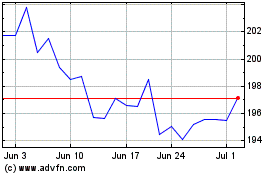Cattle, Hog Prices Fall to Multiyear Lows
October 03 2016 - 2:30PM
Dow Jones News
Cattle and hog prices have fallen to the lowest levels in years
as U.S. meatpackers produce the largest volume of meat in
history.
Last week's 9.2% slide in hog futures on the Chicago Mercantile
Exchange was a dramatic turnaround for what was the best-performing
commodity market in the first half of this year thanks to strong
pork exports to China.
"The livestock markets have been beaten to oblivion in the last
month," said Craig VanDyke, an analyst with Top Third Ag Marketing,
an agricultural advisory firm in Chicago. "It's really scary."
Live-cattle futures at the CME for October delivery midday
Monday rose 0.4% after earlier dropping as low as 97.35 cents a
pound, a six-year low. October hog futures, meanwhile, were up 0.7%
from the seven-year low of 49.325 cents a pound they touched
Friday.
The buildup has stoked concerns over a glut of meat, poultry and
other agricultural products in the U.S. Producers are on track to
send a record number of hogs and chickens to slaughter this year,
and beef production is rapidly increasing. Dairy farmers are
spoiling excess milk in their fields as warehouses pile up excess
cheese. Corn, soybean and wheat growers are also preparing for a
fourth straight year of bumper harvests this fall.
The U.S. Department of Agriculture on Friday pegged the size of
the nation's hog and pig herd on Sept. 1 at 70.851 million head,
the largest on record. That compared with 69.946 million hogs
predicted by a Wall Street Journal survey of analysts.
The figure illustrates how producers responded to lofty prices
and profitable margins at the start of the summer by breeding more
animals—before a dramatic plunge in prices to multiyear lows
reversed the economics for many farmers.
The U.S. hog herd is still growing, even as the profit potential
for many producers evaporates and export demand begins to cool.
Part of the problem is livestock's biological limits: a sow, or
female breeding pig, gestates for around four months before
delivering a litter of pigs. Market conditions can change
dramatically from the time a farmer decides to expand operations to
when those animals are ready for market.
In the week through Oct. 1, meatpackers produced 509.1 million
pounds of beef, up 5.5% from the same period last year. Output has
climbed 4.7% in 2016 over the volume produced by this time last
year.
"We've got plenty of meat and we're not moving near as much as
we should," Mr. VanDyke said.
Write to Kelsey Gee at kelsey.gee@wsj.com
(END) Dow Jones Newswires
October 03, 2016 14:15 ET (18:15 GMT)
Copyright (c) 2016 Dow Jones & Company, Inc.
CME (NASDAQ:CME)
Historical Stock Chart
From Mar 2024 to Apr 2024

CME (NASDAQ:CME)
Historical Stock Chart
From Apr 2023 to Apr 2024
